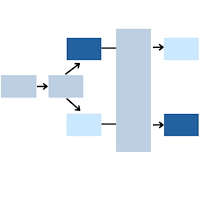Previous Posts
Transformations don’t always help, but when they do, they can improve your linear regression model in several ways simultaneously. They can help you better meet the linear regression assumptions of normality and homoscedascity (i.e., equal variances). They also can help avoid some of the artifacts caused by boundary limits in your dependent variable -- and sometimes even remove a difficult-to-interpret interaction. In this webinar, we will review the assumptions of the linear regression model and explain when to consider a transformation of the dependent variable or independent variable.
Imagine this scenario: This year’s flu strain is very vigorous. The number of people checking in at hospitals is rapidly increasing. Hospitals are desperate to know if they have enough beds to handle those who need their help. You have been asked to analyze a previous year’s hospitalization length of stay by people with the […]
In this video I will answer a question from a recent webinar Random Intercept and Random Slope Models. We are answering questions here because we had over 500 people live on the webinar so we didn't have time to get through all the questions.
In this video I will answer a question from a recent webinar Random Intercept and Random Slope Models. We are answering questions here because we had over 500 people live on the webinar so we didn't have time to get through all the questions.
Interpreting regression coefficients can be tricky. Especially when there are interactions in the model. Or categorical predictors. (Or worse – both.) But there is a secret weapon that can help you make sense of your regression results: marginal means. They’re not the same as descriptive stats. They aren’t usually included by default in our output. And they sometimes go by the name LS or Least-Square means. And they’re your new best friend. So what are these mysterious, helpful creatures? What do they tell us, really? And how can we use them?
Question: Can you talk more about categorical and repeated Time? If I have 5 waves at ages 0, 1 year, 3 years, 5 years, and 9 years, would that be categorical or repeated? Does mixed account for different spacing in time? Mixed models can account for different spacing in time and you’re right, it […]
As mixed models are becoming more widespread, there is a lot of confusion about when to use these more flexible but complicated models and when to use the much simpler and easier-to-understand repeated measures ANOVA. One thing that makes the decision harder is sometimes the results are exactly the same from the two models and sometimes the results are vastly different. In many ways, repeated measures ANOVA is antiquated -- it's never better or more accurate than mixed models. That said, it's a lot simpler. As a general rule, you should use the simplest analysis that gives accurate results and answers the research question. I almost never use repeated measures ANOVA in practice, because it's rare to find an analysis where the flexibility of mixed models isn't an advantage. But they do exist. Here are some guidelines on similarities and differences:
In a previous post we discussed using marginal means to explain an interaction to a non-statistical audience. The output from a linear regression model can be a bit confusing. This is the model that was shown. In this model, BMI is the outcome variable and there are three predictors:
We often have a continuous predictor in a model that we believe has non-constant relationship with the dependent variable along the continuum of the predictor’s range. But how can we be certain? What is the best way to measure this?
Ah, logarithms. They were frustrating enough back in high school. (If you even got that far in high school math.) And they haven’t improved with age, now that you can barely remember what you learned in high school. And yet… they show up so often in data analysis. If you don't quite remember what they are and how they work, they can make the statistical methods that use them seem that much more obtuse. So we're going to take away that fog of confusion about exponents and logs and how they work.


 stat skill-building compass
stat skill-building compass